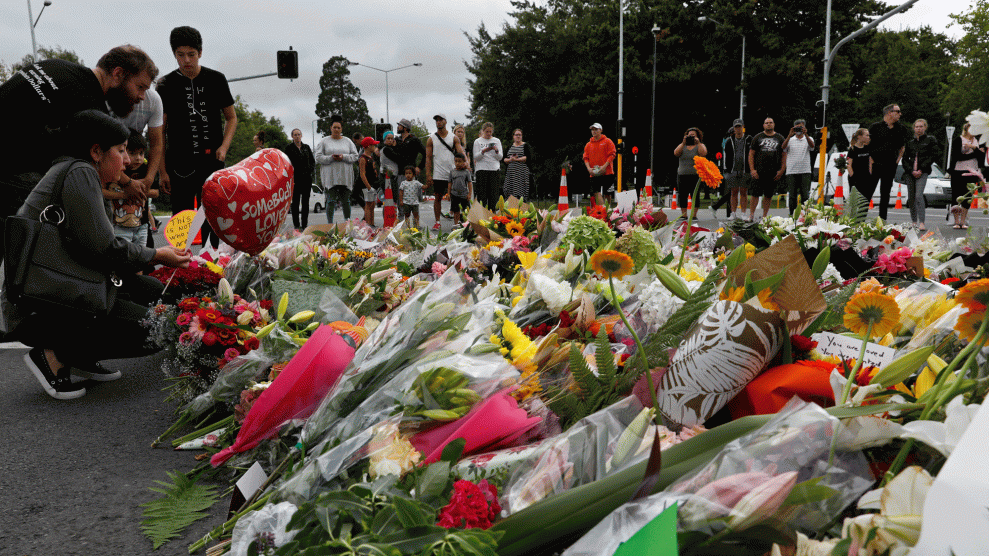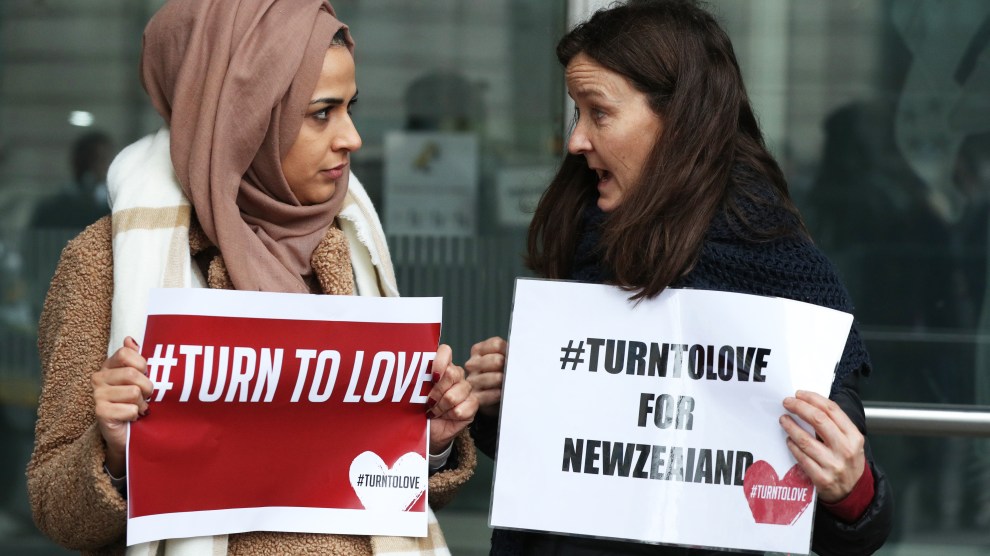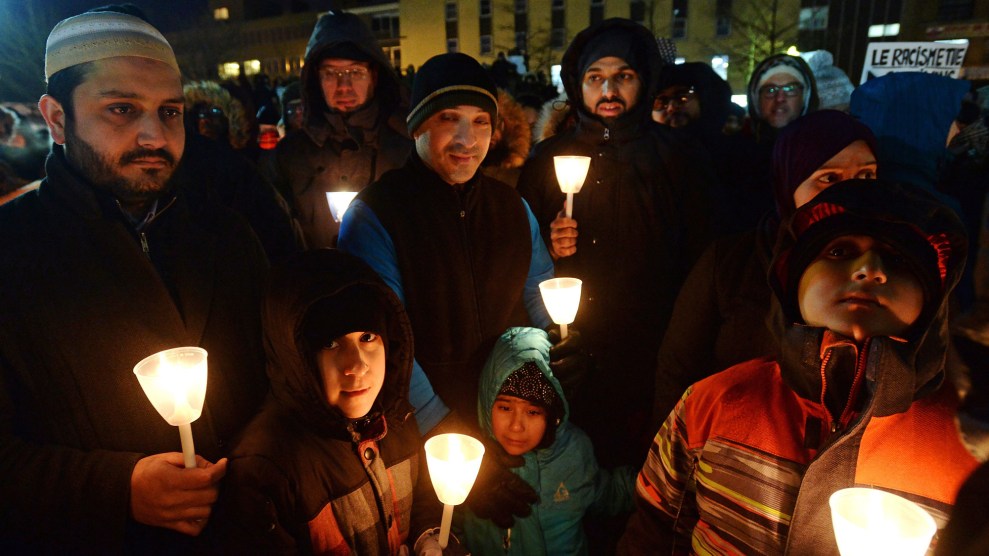
Mourners pay their respects at a makeshift memorial near the Masjid Al Noor mosque in Christchurch, New Zealand, Saturday, March 16, 2019.Vincent Yu/AP
The massacre that left at least 49 people dead and scores of others wounded in New Zealand this week highlights the white nationalist movement, as well as its grim online ecosystem, is not just an American phenomenon—it’s an interconnected global ideology. The shooter left behind a manifesto rife with the kind of online-style “shitposting” and rhetoric espoused by the resurgent white nationalist movements that have taken hold in the US, Europe, and beyond. As my colleague Ali Breland explains,
Shitposting is an internet term for pumping out low-quality and often ironic online content to get a reaction from other people. [Anti-Defamation League researcher Joel] Finklestein explained that the gunman—who live-streamed the killings and distributed a detailed manifesto full of references to far-right memes—was able to pull off an extreme and tragic version of what white nationalist internet shitposters do all the time: publish incendiary content to enrage and confuse their opponents.
In turn, the event exposed not just a single online fringe culture, but the ways in which some of these ideas have actually been mainstreamed, embraced and fueled by elected officials in the United States and elsewhere. On Friday, President Trump told reporters that the massacre was a “horrible, horrible” thing. But he soon pivoted, saying that there are “crimes of all kinds coming through our southern border.” “People hate the word ‘invasion,’” he said, “but that’s what it is.” His words echoed those of the New Zealand mosque shooter, who in his manifesto wrote, “We are experiencing an invasion on a level never seen before in history.” In fact, the shooter used the word “invasion” six times in his manifesto, and he referred to President Trump as “a symbol of renewed white identity.”
When Trump was asked if he considered white nationalism a rising threat around the world, he responded casually, “I don’t really,” and added, “it’s a small group of people” committing these crimes. However, last year, every single extremist murder in the United States was committed by a white supremacist or far-right extremist, according to the Anti-Defamation League’s annual report on extremist killings. In 2017, murders committed by white supremacists more than doubled from the previous year. There is increasing evidence of far-right groups from around the world collaborating not just online, but in real life at events and rallies aimed at spreading their ideologies far and wide.
In an attempt to unravel some of these complicated threads, Mother Jones spoke with New York Times columnist Wajahat Ali, who has written extensively on extremism. He discusses what we can learn from the New Zealand massacre about this movement, how elected officials like Donald Trump breathe life into it, and what the media needs to do to cover it.
Mother Jones: Broadly, what can we learn from this tragedy and how this white supremacist ideology is spread?
Wajahat Ali: White supremacy is a globalized, mainstream ideology of hate that not only exists in America, but also in Europe and elsewhere. It has ideological infrastructure on the Internet, which it uses to recruit, which it uses to radicalize, and which it uses to promote a hateful message. It’s like a virus, which infects angry, lonely, disaffected men and women who are seeking community and purpose. The ideology gives them a hero narrative where they can restore a romantic Western white civilization that never existed by purging it of all impurities. It is white ISIS. It has the same pathway towards radicalization and almost the same grievances. Whereas ISIS wants the caliphate, they want Valhalla.
MJ: Extremism expert JJ MacNab calls the manifesto a media-bait game, saying that it’s “filled with in-jokes and intentionally ironic references which he hopes you will waste time trying to parse.” What’s important for people to know without giving the ideas expressed in it oxygen?
WA: She’s not incorrect. You want to find out the motivations and the ideology and what triggered the individual to get clues, but at the same time, as we can see from Anders Breivik, who left behind a 1,500-page manifesto when he killed 77 people in 2011, his rationalizations were very similar to the New Zealand murderer. He wanted to punish Europe for being lax on immigration, for being pro-Muslim, for being pro-diversity. And [Breivik’s] manifesto inspired a recent domestic terrorist that just fell out of the news: Coast Guard Lieutenant Christopher Hasson [who aimed to “establish a white homeland” and was “dreaming of a way to kill almost every last person on Earth”].
Very deliberately, just like ISIS and Al Qaeda, the New Zealand shooter left a video behind. He wants to be seen, he wants to be known, he wants you to witness him. This serves as propaganda and to make them look stronger than they are. And this also serves to promote their ideology. It’s kind of a double-edged sword.
You have to be judicious and smart about what you reveal, you have to condemn it, you don’t want to give a both- sides false equivalency: “Oh, now let me give a platform to an Alt-Right member to talk for 30 minutes.” It’s very similar to anti-vaxxers and pro-vaxxers, when you give them a both-sides platform, what happens instead is it has a boomerang effect and it actually strengthens the anti-vaxxer’s case because more people start saying, “Oh, well let me see if there’s anything to it.”
What do you do when some of the hateful ideologies and thoughts and tweets come from the Oval Office, from Australian senators, from Congressman Steve King? What do you do when it’s been mainstreamed by political parties like the National Front in France? And we’re in an interesting situation where we’re in a media eco-stystem that nurtures and supports these individuals and their messages and shifting the Overton Window of what we consider acceptable. And the Republican party has a figurehead who calls white supremacists from Charlottesville “very fine people”—and now you have to do both-sides journalism and we’re put in a tricky situation.
MJ: White nationalists have praised the president, and some consider him sympathetic to their views. What effect does that have on this movement?
WA: We can just take it from their own words. They see him as their instrument, their enabler. How do we know? If you look at the manifesto of the New Zealand shooter, he said that Donald Trump is a symbol of white pride. If you look at Daily Stormer, the number-one white supremacist site, they praised Trump, they said he had an opportunity to reject them after Charlottesville, and he didn’t. The Quebec shooter, what did he do when he walked into a mosque and killed six people? He was anti-immigrant, anti-refugee, anti-Muslim, and he was supportive of Trump’s comments. Trump has created a hostile eco-system and climate that has enabled what was once considered fringe memes to come out into the mainstream.
One final example: A few months ago Donald Trump deliberately promoted a hateful, false, anti-Semitic conspiracy theory saying that Jewish billionaire George Soros was funding a caravan of illegal rapists and criminals and refugees and Middle Eastern suspects to come and invade America. This is literally taken from the swamps of white supremacist conspiracy theories and mainstreams them repeatedly from the tweets and mouth of Donald Trump—and repeated by the Republican party, which then also coincided with a man walking into a synagogue and shooting 11 people in Pittsburgh, who said he wanted to punish HIAS, the Hebrew refugee services, for their invasion.
This is an ideology that has shared roots. It’s right in front of us.
MJ: We’ve now seen American neo-Nazi groups like the Rise Above Movement travel abroad to meet with like-minded groups in Europe and Russia. Some of them have been involved in violent altercations. What do we know about these groups sharing their ideas and how people move from Internet talking points to meeting in real life to then committing acts of violence?
WA: It’s a process. Some just get radicalized but they don’t necessarily weaponize. Some people radicalize who then operate in their local community. And then some others—as with what happened with the Charlie Hebdo massacre—say, “Let’s organize a sophisticated plan.” Right now we know too little, but what we do know is that this attack was very organized, very planned, and very deliberate.
I would not be surprised if the recruitment, the radicalization, and the planning was done online, which then finally led to a physical meeting where they decided to embark on this terrible tragedy. It depends on each individual, once they cross a threshold. You hear similar themes in these attacks: I can’t wait. I have to do it. I have to be the martyr. It’s my time to do it. For example, what did Dylann Roof say? It had to be done. The NZ shooter said, I didn’t care if I died or not; I have to do it to save Western civilization. A sense of urgency compels them to be a proactive protagonist willing to be the martyr for the greater cause.
MJ: And do you have ideas about how we confront this, as media or society in general?
WA: What we have to stop doing in the media, which has been disastrous to truth, facts, to decency, is both-side journalism—creating a false equivalency where there is none. Instead, use rigorous fact checking and follow up questions to dissect the ideology. Poke holes in it. The way to really go after these recruits is show their failures, show their humiliations, show them being prosecuted. If you do that, you give them not what they want, which is a hero’s martyrdom narrative, but a narrative of failure and humiliation and ugliness. In that way you keep them from recruiting. But also you need a front-end, which is inoculation, education, a top-down model where national security, law enforcement, educators, judges, the media, all call it for what it is and apply the same standard they have when a Muslim suspect is involved in an act of terrorism to white suspects.












